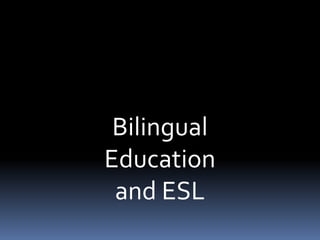
Esl powerpoint
- 1. Bilingual Education and ESL
- 2. WHAT IS ESL/Bilingual ESL is a second language program that uses only English as the instructional language for eligible students. Bilingual is a educational program that teaches non-English speaking students core subjects in their native language as they learn English.
- 3. Purpose of ESL/Bilingual Programs The purpose of ESL is to give students the opportunity to achieve English proficiency and academic mastery of subject matter content and higher order content. The purpose of Bilingual programs is to help immigrant children keep up with their peers and receive a quality education
- 4. DO the Programs Work? ESL Bilingual Studies show that English Immersion (ESL) works because of an 2 year intense study of English skill development. After mastery of the skill of English these students achieve passing scores on reading and math as well. Studies show that Bilingual education programs do not teach students the English language and literacy they need for school success. Delaying the language of English, which is a part of school and community lowered grades on test. http://www.proenglish.org/issues/education/beindex.html
- 5. Instructional Requirements Main requirement – Teach English to those that is not their native language Federal Government dictates how the program is done and the standards of the programs State Governments can choose which specific ESL program but has to meet the standards set forth by the federal government
- 6. Instructional Requirements Bilingual Education Act of 1968- directed originally at Spanish-speaking students to teach them English, but the final bill included all those whose dominant language is other than English 1974 Amendment – include those with limited English speaking ability Equal Education Opportunity Act of 1974 - three factors federal government uses to see if state and school districts are complying School program based upon sound education theory or principles School program reasonably calculated to implement education theory effectively After period of time, program’s results showing language barriers being overcome
- 7. Issues Resolved Regarding Implementation The recruitment of certified bilingual teachers The “ghettoization” and politicization of bilingual education Race relations in the district A community consensus on bilingual education as a pedagogical strategy across language needs
- 8. Tools and Testing Materials Used Skill Area Tested Videos Newspapers Magazines Personal reading material “Real world” language instead of “textbook” language Listening Comprehension Reading Writing
- 9. Qualification Requirements The qualification requirements for a student to be considered a candidate for English as a Second Language student is determined by the teachers use of the home language survey. The students can then become eligible based on the information from that survey.
- 10. The survey helps determine the level of English proficiency of the student. If a student scores at DPI (Department of Public Instruction) levels 1-5, the student qualifies for ESL/Bilingual education services. If a student scores a DPI level 6, the student is determined fully English proficient and does not qualify for ESL/Bilingual education services.
- 11. After families have been given information about ESL/Bilingual education, they have the right to either accept or decline these services. Families also have the right to change their decision at any time during the student's career in school
- 12. All states have a statute that requires schools to design a program for ESL and prepare a formal plan of services to meet the needs of bilingual students. The statute should also require that the program is staffed by a licensed bilingual teacher.